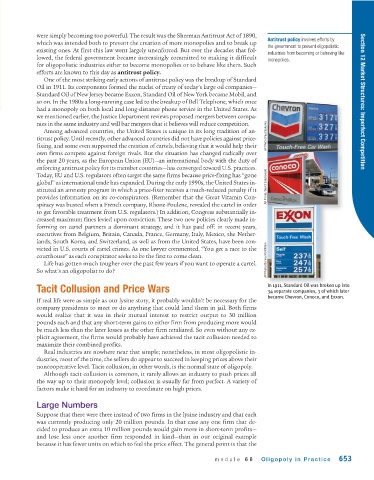Page 695 - Krugmans Economics for AP Text Book_Neat
P. 695
were simply becoming too powerful. The result was the Sherman Antitrust Act of 1890,
Antitrust policy involves efforts by
which was intended both to prevent the creation of more monopolies and to break up
the government to prevent oligopolistic
existing ones. At first this law went largely unenforced. But over the decades that fol-
industries from becoming or behaving like
lowed, the federal government became increasingly committed to making it difficult monopolies.
for oligopolistic industries either to become monopolies or to behave like them. Such
efforts are known to this day as antitrust policy.
One of the most striking early actions of antitrust policy was the breakup of Standard
Oil in 1911. Its components formed the nuclei of many of today’s large oil companies—
Standard Oil of New Jersey became Exxon, Standard Oil of New York became Mobil, and
so on. In the 1980s a long-running case led to the breakup of Bell Telephone, which once Section 12 Market Structures: Imperfect Competition
had a monopoly on both local and long-distance phone service in the United States. As
we mentioned earlier, the Justice Department reviews proposed mergers between compa-
nies in the same industry and will bar mergers that it believes will reduce competition.
Among advanced countries, the United States is unique in its long tradition of an-
titrust policy. Until recently, other advanced countries did not have policies against price- AP Photo/Paul Sakuma
fixing, and some even supported the creation of cartels, believing that it would help their
own firms compete against foreign rivals. But the situation has changed radically over
the past 20 years, as the European Union (EU)—an international body with the duty of
enforcing antitrust policy for its member countries—has converged toward U.S. practices.
Today, EU and U.S. regulators often target the same firms because price-fixing has “gone
global” as international trade has expanded. During the early 1990s, the United States in- AP Photo/David Zalubowski
stituted an amnesty program in which a price-fixer receives a much-reduced penalty if it
provides information on its co-conspirators. (Remember that the Great Vitamin Con-
spiracy was busted when a French company, Rhone-Poulenc, revealed the cartel in order
to get favorable treatment from U.S. regulators.) In addition, Congress substantially in-
creased maximum fines levied upon conviction. These two new policies clearly made in-
forming on cartel partners a dominant strategy, and it has paid off: in recent years,
executives from Belgium, Britain, Canada, France, Germany, Italy, Mexico, the Nether-
lands, South Korea, and Switzerland, as well as from the United States, have been con-
victed in U.S. courts of cartel crimes. As one lawyer commented, “You get a race to the
courthouse” as each conspirator seeks to be the first to come clean. AP Photo/Donna McWilliam
Life has gotten much tougher over the past few years if you want to operate a cartel.
So what’s an oligopolist to do?
Tacit Collusion and Price Wars In 1911, Standard Oil was broken up into
34 separate companies, 3 of which later
became Chevron, Conoco, and Exxon.
If real life were as simple as our lysine story, it probably wouldn’t be necessary for the
company presidents to meet or do anything that could land them in jail. Both firms
would realize that it was in their mutual interest to restrict output to 30 million
pounds each and that any short-term gains to either firm from producing more would
be much less than the later losses as the other firm retaliated. So even without any ex-
plicit agreement, the firms would probably have achieved the tacit collusion needed to
maximize their combined profits.
Real industries are nowhere near that simple; nonetheless, in most oligopolistic in-
dustries, most of the time, the sellers do appear to succeed in keeping prices above their
noncooperative level. Tacit collusion, in other words, is the normal state of oligopoly.
Although tacit collusion is common, it rarely allows an industry to push prices all
the way up to their monopoly level; collusion is usually far from perfect. A variety of
factors make it hard for an industry to coordinate on high prices.
Large Numbers
Suppose that there were three instead of two firms in the lysine industry and that each
was currently producing only 20 million pounds. In that case any one firm that de-
cided to produce an extra 10 million pounds would gain more in short-term profits—
and lose less once another firm responded in kind—than in our original example
because it has fewer units on which to feel the price effect. The general point is that the
module 66 Oligopoly in Practice 653

